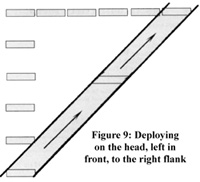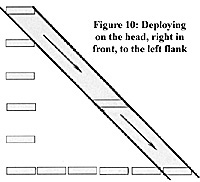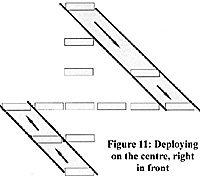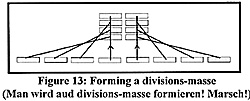Deploying an Open Column in Line of Battle to the Front
Let us now consider perpendicular deployment into line of battle. Figure 17 in my original article shows this being conducted from open column right in front and needs no further explanation really. My description of actual deployment, however, needs some slight modification. Gunther Rothenberg states that the Austrians favoured conversion on the senior sub-unit,
[29]
I hesitate to contradict a historian of Professor Rothenberg's stature, and he may yet be correct, but I cannot find the statement to this effect in the Exercier-Reglement 1807. Deployment from column to line, and 'ployment' from line to column, appears to be conducted to either flank as required. My original notes are not actually incorrect but they imply that deployment was possible only to one flank, which was not the case. Be that as it may I will examine the variations in some detail.
We now turn to Paragraph 5 to Section 3, Deploïrung. This is probably the most important element to the current discussion. It is worth examining the preamble to this instruction because it encapsulates the tactical doctrine of Austrian infantry in a couple of paragraphs.
"Through deploying, a unit will be placed in a state to attack or receive an attack of the enemy. This movement must of necessity by conducted near to and under the eyes of the enemy, and requires particular attentiveness, rapidity and precision". [30]
Again one sees that the column was, quite clearly, a tool of manoeuvre. The principal tactical formation for Austrian infantry, both in attack and defence, remained the line. This should not be interpreted, as has been done by some recent commentators, that the Austrians used 18th Century linear doctrine. They did not, as a brief look at some tactical examples later will show. To continue, it is also very obvious that the column was expected to move throughout the tactical environment, and to deploy just short of the point of contact. From the description this must mean under artillery fire although, ideally, it would have been beyond the effective range of musketry. This philosophy was universal by this time.
The column was capable of deploying on the head, on the centre, or on the rear, none of which was unique to the Austrian service. Of particular interest, however, is that it did so using an inclined march at the doublirschritt [31] (also called the "schrägen schritt" [32]). The inclined, or oblique, march was well enough known at the time. [33] One wonders what the advantage might have been.
One advantage, if it can be called that, is that the deploying sub-units maintained a front parallel with the alignment, and the perceived threat, as they moved 'crab-wise'. Another, perhaps, is that it might have made deployment from column at half-distance easier but that is merely speculation on my part. The disadvantage is that dressing is harder to maintain. Elsewhere in the Exercier-Reglement 1807 one also finds descriptions conversions using the conventional quarter wheel [34] although not, apparently, for deploying in line of battle for the specific purpose of combat, as described here.
To deploy in line of battle on the head the cautionary command was
'Deploïren' is not a word found in any modern German dictionary I own and, presumably, is derived from the French 'déployer'. It will be noted that many French terms appear in all regulations of the period. The sense of 'deploïren' here means to form a line. Unfortunately, 'aufmarschiren' also means deploy, but the implication here is the march by which it is executed. One encounters 'aufstellen' in similar vein, usually in the context of formations. In any event the executive was, "Marsch!"
There then follows instructions that the column deploys on the 'Tête' (head) or first sub-unit by causing the subsequent sub-units to 'draw out' behind it. The first sub-unit gave the dressing for the remainder which ensured that they remained perpendicular to the position of the column and parallel to the alignment throughout the conversion.
It then goes on to stress the importance of the 'point de vue' and 'point d'appui' in deploying manoeuvres. The 'point de vue' was merely a reference point on which a unit marched, such as a tree or steeple, for example. In the absence of these than an officer had to ride out and place himself on the new alignment to give the battalion a reference point on which to march. A good job, or what! The 'point d'appui' was the point on which the unit anchored its flank. This is all basic stuff, found in every regulation of the period.
Deployment was also possible on the last sub-unit. In which case cautionary was
followed by
The rear sub-unit stood fast whilst the remainder executed an 'about turn' becoming retired. The next cautionary was
"Marsch!"
Deployment on the centre was also allowed. The cautionary was
followed by
"Der rechte oder linke Flügel, rechts um!" (The right or left Flank, about turn!")
at which point, depending upon whether the column was in normal configuration with the right in front in which case, the right flank 'about turned', or, if reversed order with the left in the front in which case, the left flank 'about turned'.
The next command was
The fourth half-division from the front of the column, that is to say the first sub-division of the flank forming the rear half of the column, stood fast whilst those to its front and rear marched onto the alignment on its right and left respectively. At this point the line would have half its sub-units advanced and half retired, in other words facing the rear and inverted. These latter were now given the order
Turn now to page 92 of your Exercier-Reglement 1807. No talking. Pay attention and no looking out of the window.
Paragraph 6 to Section 3 contains the final instructions for breaking and forming line and deals with the closed column "Aufmarsch aus der Masse". [35] Because of its closed nature, the masse had two alternatives if it wanted to deploy. The first was to open its intervals, in which case deployment took place as already described above. The other was to deploy from closed configuration which it did by means of a flank march of files. It could do so either on the head, the rear, or centre as could the column. The essence of the preamble is this
This lends support the earlier speculation that the masse was probably the most common formation. There would appear to be nothing to be gained by opening intervals prior to deployment. Of special interest is the remark that deployment using the 'schrägen doublirschritte' used in deployment from open column was particularly tiring and It is possible to speculate that this was another reason why the masse might have been preferred.
To deploy the masse on the head the cautionary command was
followed by
at which individuals in each sub-unit, except the first which stood fast, executed a 90 degree right or left turn as appropriate then
Deployment on the rear was ordered thus
"Rechts um!" ("about turn!") for the sub-units in front of the rear sub-unit which stood fast, and
"Schließt euch, Marsch!" ("Close order dress, March!")
"Halb rechts oder halb links! Aufmarschirt!" ("Half right or half left! Deploy!")
Once having filed into the new alignment the deploying sub-units were halted and faced towards the front again. Similarly deployment on the centre was given thus
"Der rechte oder linke Flügel rechts um!" ("The right or left Flank about turn!") and
"Beide Flügel schliest euch. Marsch!" ("Both Flanks close order dress, March!") then
"Halb rechts oder halb links!" "Aufmarschirt!" ("Half right or half left turn!" "Deploy!") whereupon the sub-units filed into the new alignment as already described. The closed column examined above was formed typically by a battalion on a half-division frontage, although the Exercier-Reglement 1807 also makes reference to a regimental sized masse formed on a division. Interestingly enough I have found no documented example of such a formation being used in the 'western' theatre although it should not be inferred that this did not occur. It should also be remembered that the Austrians had enemies other than the French. On their eastern borders such a large target, three battalions in a close order column, would be in significantly less danger from the fire of comparatively unsophisticated opponents. No mention has been made yet of the divisions-masse, a formation over which there is probably more controversy than any other.
The question is whether a battalion could divide into two massen, each of three half-divisions, or not. According to Dr Rothenberg, [36]
I reflected this in my original article but I have to say that I have found no mention of a divisions-masse consisting of three half-divisions (companies) in the Exercier-Reglement 1807. It would appear, however, that Pr. Rothenberg is only wrong in his terminology. We have already established that an Austrian battalion could divide into two half battalions for tactical purposes, formed from left and right wings (flügel), and that there appears no reason why these should not close in masse if need be. On the other hand, they are not divisions-masse, except, I suppose, in the sense that the battalion has divided into two.
It is also worth commenting on Figure 18 in my original article which is after a copy of Plan 60 from the Exercier-Reglement 1807, the source of which has already been mentioned. [37] This appears to show a half-battalion (12 züge) in zug column, doubling frontage to produce two massen, each of three half-companies, from which one might infer four such massen from a battalion. I have not yet found this described in the text of the Exercier-Reglement 1807. It does, however, show the means of doubling the frontage of a column, a method of which the Austrians had no monopoly.
Lets return to the text then. According to the Exercier-Reglement 1807
This formation then, was, apparently, only an extemporised defence against cavalry, nothing more. We shall see, however, that there are other examples of divisions being used as separate tactical sub-units.
The cautionary was
the executive
Please note that the two centre züge did not retire, as stated in my earlier article (FE17). This was a mistake brought about by pasting my illustration up-side down and then describing it. In order to avoid a repetition of the error I have prepared this article whilst standing on my head and using my feet. What I really did was describe it first and then draw it.
To summarise what we have discovered about Austrian tactical practice and interpret what it may mean.
More As You Were
"regulations recommended the battalion column formed from the line on the right flank company ...."
" A column in which the sub-units are still at wheeling-distance from one another, is deployed with the oblique 'doublirschritt' and drawn up 'en front'".
"Man wird rechts oder links deploïren, und 'en front' aufmarschiren!". (Essentially "Form line to right or left, and deploy to the front").
 Deployment was performed by an inclined oblique march, rather than quarter wheel, to the flank indicated and onto the alignment. This would have involved an incline, or quarter pivot (45 degrees), at the start and end of the march. An illustration is at Figure 9.
Deployment was performed by an inclined oblique march, rather than quarter wheel, to the flank indicated and onto the alignment. This would have involved an incline, or quarter pivot (45 degrees), at the start and end of the march. An illustration is at Figure 9.
"Man wird auf die letzte Abtheilung aufmarschieren!" ("Deploy on the rear sub-unit!")
"Rechts um!" ("Right about turn!")
'Rechts oder Links deploïrt!' ("Right or Left form line!"), followed by
 The sub units marched onto the alignment as before, but inverted this time, where they were halted and were given the order "Front!" ("about turn") which then returned them to the advance position alongside the rear sub-unit. An illustration is at Figure 10.position alongside the rear sub-unit. An illustration is at Figure 10.
The sub units marched onto the alignment as before, but inverted this time, where they were halted and were given the order "Front!" ("about turn") which then returned them to the advance position alongside the rear sub-unit. An illustration is at Figure 10.position alongside the rear sub-unit. An illustration is at Figure 10.
"Man wird auf der Mitte aufmarschiren!" ("On the Centre deploy!")
"Rechts oder links deploïrt!" and "Marsch!" ("Right or left form line!" and "March!").
"Front"! ("about turn").
 Advancing them. An illustration is at Figure 11.
It only remains to examine the deployment of massen to complete basic column to line conversions.
Advancing them. An illustration is at Figure 11.
It only remains to examine the deployment of massen to complete basic column to line conversions.
Deploying from Masse
"From the explanation, already given in Section 2 to Chapter 3, deployment from masse in battle order is made easier than from column because the terrain does not always allow deployment throughout the depth of a column, and the last sub-unit, through use of the inclined 'doublirschritt' ("schrägen doublirschritt") often arrives on the formed line greatly tired."
"Man wird aus der Masse aufmarschiren!" ("Deploying from Masse!")
"Halb links oder halb rechts!" ("Half left or right turn!")
"Aufmarschirt!" ("Deploy!")
 and marched in file onto the new alignment next to the first sub-unit. This does not appear to be a square 'en tiroir' manoeuvre, but a direct filing into position on the new alignment. An illustration is at Figure 12.
and marched in file onto the new alignment next to the first sub-unit. This does not appear to be a square 'en tiroir' manoeuvre, but a direct filing into position on the new alignment. An illustration is at Figure 12.
"Man wird auf der hintern Abtheilung aufmarschiren!" ("Deploy on the rear sub-unit!")
followed by
"Man wird auf der Mitte aufmarschiren"! ("Deploy on the Centre!") then
The Divisions-Masse
"The so called 'division mass' comprised two three-company deep columns, about 11 to 13 yards deep, and with a two-company frontage about 30 to 32 yards wide. These two columns were to operate abreast but separated by some 60 paces. Another recommended formation was to draw up a battalion in three divisions of two companies each "
"When the circumstances or the time do not permit a battalion to form square, a defence from enemy cavalry is found in the divisions-masse" [38]
"Man wird auf Divisions - Masse formieren!" ("Form in Divisions-Masse!")
"Marsch!" ("Quick as you like!" or words to that effect.).
 At this point the battalion was in line and on receipt of the command the centre two züge marched forwards at the doublirschritt whilst the remainder wheeled in behind them and closed to rank-distance. Thus the battalion formed in three divisions-massen, or division sized closed columns, each consisting of two half-divisions formed on a half-company frontage. I have found no mention of any other kinds of divisions-massen in the Exercier-Reglement 1807. An illustration is at Figure 13.
At this point the battalion was in line and on receipt of the command the centre two züge marched forwards at the doublirschritt whilst the remainder wheeled in behind them and closed to rank-distance. Thus the battalion formed in three divisions-massen, or division sized closed columns, each consisting of two half-divisions formed on a half-company frontage. I have found no mention of any other kinds of divisions-massen in the Exercier-Reglement 1807. An illustration is at Figure 13.
Conclusions
Introduction and Battalion Organization
Column, Masse, and Breaking
Deploying
Tactial Examples, Footnotes
Back to Table of Contents -- First Empire #25
Back to First Empire List of Issues
Back to MagWeb Master Magazine List
© Copyright 1995 by First Empire.
This article appears in MagWeb (Magazine Web) on the Internet World Wide Web. Other military history articles and gaming articles are available at http://www.magweb.com